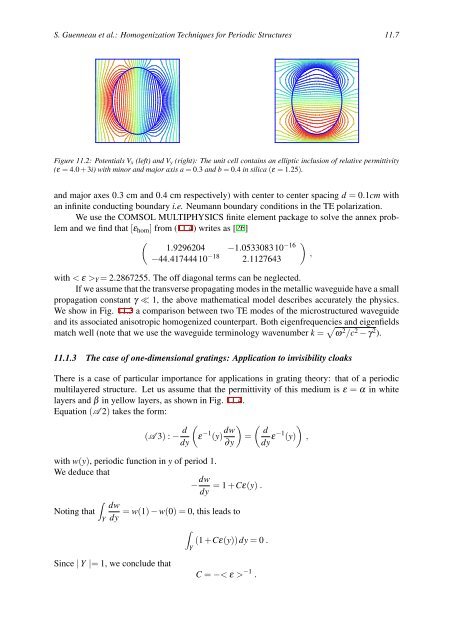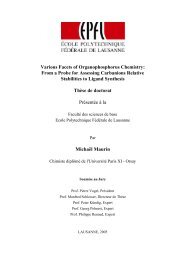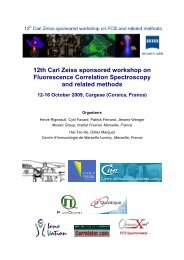GratinGs: theory and numeric applications - Institut Fresnel
GratinGs: theory and numeric applications - Institut Fresnel
GratinGs: theory and numeric applications - Institut Fresnel
Create successful ePaper yourself
Turn your PDF publications into a flip-book with our unique Google optimized e-Paper software.
S. Guenneau et al.: Homogenization Techniques for Periodic Structures 11.7<br />
Figure 11.2: Potentials Vx (left) <strong>and</strong> Vy (right): The unit cell contains an elliptic inclusion of relative permittivity<br />
(ε = 4.0 + 3i) with minor <strong>and</strong> major axis a = 0.3 <strong>and</strong> b = 0.4 in silica (ε = 1.25).<br />
<strong>and</strong> major axes 0.3 cm <strong>and</strong> 0.4 cm respectively) with center to center spacing d = 0.1cm with<br />
an infinite conducting boundary i.e. Neumann boundary conditions in the TE polarization.<br />
We use the COMSOL MULTIPHYSICS finite element package to solve the annex problem<br />
<strong>and</strong> we find that [εhom] from (11.4) writes as [26]<br />
(<br />
1.9296204 −1.053308310−16 −44.41744410−18 )<br />
,<br />
2.1127643<br />
with < ε >Y = 2.2867255. The off diagonal terms can be neglected.<br />
If we assume that the transverse propagating modes in the metallic waveguide have a small<br />
propagation constant γ ≪ 1, the above mathematical model describes accurately the physics.<br />
We show in Fig. 11.3 a comparison between two TE modes of the microstructured waveguide<br />
<strong>and</strong> its associated anisotropic homogenized counterpart. Both eigenfrequencies <strong>and</strong> eigenfields<br />
match well (note that we use the waveguide terminology wavenumber k = √ ω 2 /c 2 − γ 2 ).<br />
11.1.3 The case of one-dimensional gratings: Application to invisibility cloaks<br />
There is a case of particular importance for <strong>applications</strong> in grating <strong>theory</strong>: that of a periodic<br />
multilayered structure. Let us assume that the permittivity of this medium is ε = α in white<br />
layers <strong>and</strong> β in yellow layers, as shown in Fig. 11.4.<br />
Equation (A 2) takes the form:<br />
(A 3) : − d<br />
dy<br />
(<br />
ε −1 (y) dw<br />
) (<br />
d<br />
=<br />
∂y dy ε−1 )<br />
(y) ,<br />
with w(y), periodic function in y of period 1.<br />
We deduce that<br />
− dw<br />
= 1 +Cε(y) .<br />
dy<br />
∫<br />
Noting that<br />
Y<br />
dw<br />
dy<br />
Since | Y |= 1, we conclude that<br />
= w(1) − w(0) = 0, this leads to<br />
∫<br />
Y<br />
(1 +Cε(y))dy = 0 .<br />
C = −< ε > −1 .













